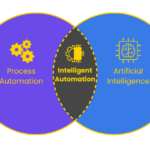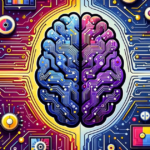Generative AI has recently catapulted into the mainstream with astonishing speed. This sudden jump into the spotlight may have taken many by surprise, but it is actually the result of decades of hard work and research in artificial intelligence. Today, advancements in computing power and data availability have made solutions like generative AI far more accessible and user-friendly, opening the door for almost anyone to harness their capabilities.
A Salesforce survey of senior IT leaders shows that 67% are placing a high emphasis on incorporating generative AI into their business strategies in the next 18 months. Of these, 57% view it as a ‘game-changer’, and a third (33%) consider it a top priority for their operations.[1]
It’s clear that this technology holds great potential for many industries going forward, so understanding how it works and impacts your business is essential. It’s equally important to explore the risks and ethical considerations involved.
What is Generative AI?
In very simple terms, it’s a type of artificial intelligence that generates content. Generative AI tools vary in their applications: some process and generate content within the same medium, like text-to-text chatbots, while others operate across different media, such as converting text prompts to images or transforming audio into text.
This versatility allows for a wide range of innovative applications in various fields:
| TYPE OF MODEL | FUNCTION | EXAMPLE USE CASES |
| Large Language Models (LLMs) | Generate and interpret text. | Chatbots, content creation, and language translation. |
| Image Generation Models | Create images from textual descriptions. | Art creation, design mock-ups, and educational visuals. |
| Speech Synthesis Models | Convert text to speech. | Voice assistants, audiobooks, and accessibility tools. |
| Speech Recognition Models | Transform spoken words into written text. | Transcription services, voice commands, and dictation software. |
| Music Generation Models | Compose music based on certain inputs or styles. | Creating soundtracks, experimenting with music styles, and music education. |
| Video Generation Models | Generate or modify video content. | Film production, advertising, and virtual reality. |
| 3D Model Generation | Create or alter 3D models. | Gaming, architecture, and virtual simulations. |
Decoding large language models (LLMs)
Trained to produce text by learning from vast amounts of data, LLMs are among the most widely discussed and visible examples of generative AI in the public domain, particularly due to their versatility and wide range of applications. These models, which are trained on billions of words and phrases from diverse sources like websites and books, excel in various natural language processing (NLP) tasks, such as language translation, question answering and summarisation.
Implemented as deep neural networks, LLMs process and transform input data, adjusting their parameters during training to closely match the desired output. This learning process enables them to discern patterns and relationships in the data, allowing them to generate coherent, contextually relevant text.
In simpler terms, think of an LLM as someone who is learning to cook. At first, they follow recipes (input data). As they learn what ingredients usually go together and how to combine them to make tasty dishes (coherent text), they get better and better over time. These continually improving cooking skills (adjusting parameters) come from practice and learning from mistakes, just like how an LLM gets better at generating text by processing lots of information and adjusting its approach.
ChatGPT epitomises the advancements in this field
ChatGPT, developed by OpenAI, was first released to the public in November 2022. The response to its release was notably enthusiastic and widespread, capturing significant attention both in the tech community and among the general public.
This tool is essentially a machine learning and statistical model that operates by analysing patterns in the vast amount of text data it was trained on. It then uses these patterns to predict the most likely next word or phrase in a given context. This process relies heavily on statistical probabilities based on the frequency and relationships of words and phrases in its training data. So, while it doesn’t “understand” language in the human sense, it uses statistical methods to generate responses that are often coherent and contextually appropriate.
As a machine learning model, it continually improves its performance through exposure to more data, refining its ability to understand and respond to diverse prompts.
Using Generative AI in your business: Be mindful of its limitations
Generative AI offers remarkable capabilities, but it’s by no means infallible or 100% dependable. Even as it continues to grow more sophisticated, it’s crucial to recognise the limitations of this technology.
- It’s doesn’t truly understand what it is saying: While ChatGPT can mimic human-like text, it doesn’t possess an actual understanding of the content or the world.
- It can perpetuate biases in its training data: Since ChatGPT and similar AI models learn from vast datasets comprising human-generated text, they inherently absorb the biases present in this data. These biases could be related to gender, race, culture, socio-economic status or other factors.
- It’s contextual awareness is limited: ChatGPT’s knowledge is confined to the data available up to its last training update. Therefore, it lacks information on events or developments that occurred thereafter, which impacts the accuracy of its outputs.
- It can spread misinformation: LLMs can generate plausible but factually incorrect responses, a phenomenon sometimes called an AI ‘hallucination’. These can be so well written and argued that it can be difficult to separate fact from fiction.
These issues could have an impact that reaches far beyond damaging your company’s credibility or reputation. They could also pose risks to the safety of your employees, partners and clients. As pointed out in Harvard Business Review, for example, “the risk of harm when a generative AI chatbot gives incorrect steps for cooking a recipe is much lower than when giving a field service worker instructions for repairing a piece of heavy machinery”.
How to manage these risks
As the technology grows more advanced – and its applications more innovative – your business will need to continually adapt your protocols. Here are some considerations:
- Regularly test the AI system for accuracy and reliability.
- Establish a set of ethical guidelines specific to AI use, focusing on how your solutions handle data and guide decisions.
- Educate employees about the capabilities and limitations of generative AI, so they are better positioned to understand, identify and mitigate potential risks.
- Have a system in place where human oversight complements AI decision-making, allowing humans to review and validate AI-generated content or decisions.
- Stay informed about and comply with all relevant laws and regulations concerning AI, with a focus on data protection, intellectual property rights and industry-specific regulations.
- Importantly, be transparent with customers, employees and partners about how AI is being used in your organisation.
Looking ahead
Generative AI technology offers immense potential to transform the way we work, communicate, share information and insights. The truth is, we are only just beginning to understand its power and impact. From ensuring accuracy to upholding ethical standards, the path to integrating generative AI calls for a nuanced and current understanding of its capabilities and limitations.
By adopting a proactive, informed approach – prioritising regular testing, ethical guidelines, employee education and transparent communication – your organisation can harness the power of generative AI in a way that’s responsible, effective and aligned with your core values.
[1] https://www.salesforce.com/news/stories/generative-ai-research/






